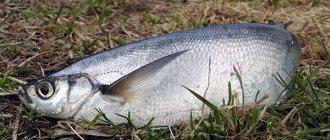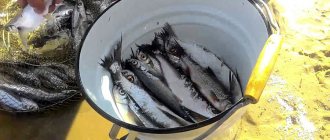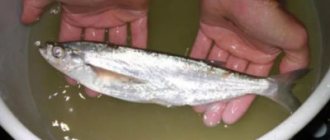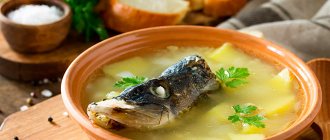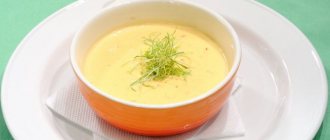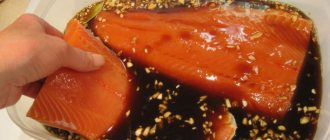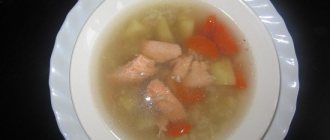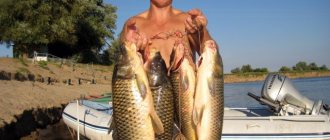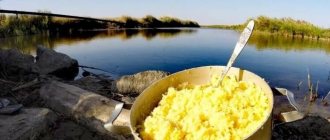About saberfish in general
Chekhon is a schooling, semi-anadromous fish of the carp family. Chukhon, Czech, boknya, saber fish, sablica - that’s how it can be called in different places. It has a long narrow saber-shaped body up to 60 cm long and weighing up to two kilograms.
Chekhon spawning occurs in early May - mid-June, when the water temperature reaches 12 - 15 °C and above. Before this, a massive spring movement of sabrefish begins, which in huge flocks rises along the rivers, adhering to the upper and middle water horizons.
The largest catches of sabrefish occur during the spring and autumn runs. The sabrefish are caught using a spinning rod and a float rod with a maggot or worm as bait. On the Volga, to catch sabrefish, fishermen use bottom tackle “rubber band”.
Cooking features
An adult sabrefish can reach a length of 60 cm and weigh about 2 kilograms, but more often the catch is more modest. It usually consists of fish weighing up to 1 kg. The choice of method for salting and preparing fish may have some differences related to its size, but the general technological principles remain the same. Knowing and taking into account several important points, even a novice cook can successfully cope with the task.
- Fish caught in spring or autumn is best suited for salting and drying, as it contains more fat and has better organoleptic qualities.
- It is recommended to salt and dry fresh fish. If it has been frozen, use it only if you are sure it was frozen when it was fresh. Allow the fish to thaw in natural conditions so that it does not lose its juiciness.
- Whether to gut fish before salting depends on its size. Specimens weighing up to 0.5 kg are usually cooked whole; larger carcasses must be gutted. When gutting, try not to damage the gall bladder, otherwise the fish will acquire an unpleasant bitter taste. When gutting, they try to leave the film lining the inside of the sabrefish's abdomen. It will prevent fat from leaking out of the fish, making the snack more tasty and healthy.
- Chekhon can be salted dry or wet. The first option is suitable for small-sized fish, the second is universal. The wet method may involve salting the fish in its own juice, brine or marinade. The choice depends on the size of the fish and the result you want to get. In the marinade, sichel is usually salted for consumption as a ready-made snack without subsequent drying.
- The duration of salting fish depends on the chosen method and the size of the saberfish. Usually small fish are salted in 2-3 days, large fish in 5-7 days.
Before drying or drying, salted sabrefish must be soaked in clean or slightly acidified water with vinegar. Dry it in a well-ventilated area for 10-20 days. The period depends on the ambient temperature and the size of the saberfish.
Dried chekhon
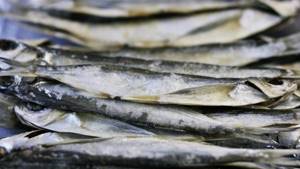
You can make anything from saber fish, but the most delicious is salted and dried sabre. In this form, chekhon has a very pleasant aroma and taste. Dried sabrefish is famous for its fat content; when cutting the fish, the fat literally runs down your hands.
The entire process of obtaining dried saberfish consists of two stages:
- Salting;
- Withering.
There are two ways to salt saber for drying:
- Dry salting;
- Salting in brine (in brine).
Salting sabrefish is not much different from salting other types of fish, but there are some nuances. All of the salting methods described are suitable for drying any fish.
The best recipe for quick baked fish
Chekhon cooked in the oven is a very juicy dish. This culinary masterpiece is good with any sauce and vegetables. To prepare the dish you will need:
- fish ─ 0.5 kg;
- milk ─ 50 g;
- breadcrumbs ─ 30 g;
- oil ─ 2 tbsp. l.;
- spices (pepper, salt).
First of all, you should clean the casing from entrails and scales and wash it thoroughly. Then divide it into portions and dip it in salted milk. Next, roll the pieces in breadcrumbs and place on a baking sheet, previously generously greased with vegetable oil. Bake in the oven for about a quarter of an hour at 180 degrees. Preheat the cabinet ─ 5 minutes.
Video: Recipe for making delicious saber fish
Dry-salted saber
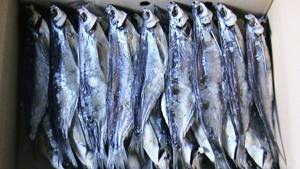
Dry salting means that the juice secreted by the fish will drain from the container in which the saber fish is located. Chekhon is salted without brine. For 10 kg of fish, approximately 1.5 kg of salt is required.
For dry salting, a wooden box with slits through which the fish juice will escape is suitable. A clean canvas cloth is placed at the bottom of the box, which is sprinkled with a layer of salt on top.
For dry salting, saber fish rolled in salt is placed in a row with heads to tails, bellies on top, tilted to one side. The casserole laid in this way is sprinkled with an additional layer of salt on top.
Salt consumption – 150 grams per kilogram of fish. After this, the fish is covered with a lid or board in the shape of the container and lightly pressed down with pressure. You should not place a large load; the weight of the lid itself will be enough if it is heavy and the fish are pressed tightly together.
The fish is salted in a cool place (cellar or refrigerator) for 3 to 10 days, depending on the size. After this, the saber fish is ready for soaking and drying.
Fishing and spawning
In addition to the fact that chukhon is caught on an industrial scale, it is also very popular among amateur fishermen.
Chekhon spawns in April-June. The beginning of spawning depends on the water warming up to 12 degrees Celsius. The fish begin to gather in large schools and swim to the spawning site. Marine populations move into rivers, upstream. Description of the most suitable place for spawning: deep water, with a fast current, which makes it possible to supply the eggs with a large amount of oxygen.
Spawning begins at sunrise, when there is fog over the water, and lasts continuously for 3-4 days. The youngest females begin it, and the oldest complete this process. During the spawning process, a flock of thousands of individuals behaves very actively, looking as if the water is boiling. Often individuals jump out of the water. Considering that the scales have a mirror-like appearance, an unforgettable active spectacle with light effects takes place in the water.
The spawned females are carried away by the current. The eggs have a diameter of 2-2.5 mm. Once in an aquatic environment, their porous shell swells and their size increases to 5 mm.
After 3-5 days the larvae hatch. On the 10th day, the fry switch to feeding on zooplankton. The current gradually carries them from the spawning site to the habitat of their parents.
When the marine population of chukhon leaves the rivers, a small number of resident fish may go with it.
Morning and afternoon are the most productive times for active mower fishing. At this time, the chukhon is hungry and actively goes on the hook.
Fishing on an industrial scale is carried out in August-September. At this time, the fish, having eaten up before winter, are the largest and fattest.
They catch fish from boats with nets.
Czech fish are well caught using a spinning rod, a fishing rod, a donkey, or an elastic band.
Suitable baits include: worms, bloodworms, maggots, steamed corn, bread, grasshoppers, flies, dragonflies, silicone or foam balls. When using a spinning rod, sabrefish respond well to wobblers, flies, twisters, and vibrotails. Mostly the heaviest specimens are fished with a spinning rod.

When casting a fishing rod, you need to wait until the hook reaches the bottom and then twitch. The same with spinning. Chukhon reacts well to moving bait and catches it well. When fishing fish out of water, it is worth using a landing net, since sabrefish have very delicate lips and can fall off the hook, tearing the lip, under the weight of its body.
When fishing with a feeder (donka), first throw a feeder with bait several times to lure the school. The feeder must be tied to the tackle, and it must contain soil for weighting.
Chekhon "wet" salting

This is the most popular method - saber fish is salted in its own juice. For 10 kg of sabrefish, you will need approximately 1 kg of salt.
In both wet and dry salting, the fish is placed in a container, the surface of which does not undergo oxidation upon contact with salt - an enamel or plastic basin, bucket, or large pan will do.
The bottom of the container is sprinkled with a small layer of salt. The fish is laid sideways, or belly up at an angle, as in the previous method. Each layer of fish is sprinkled with a separate layer of salt. Salt consumption is approximately 100 grams per 1 kg of saber fish.
After placing the fish, it is covered with a lid. Over time, the fish will release juice and become completely covered in it. The weight is only necessary to prevent the saber fish from floating up. The fish should not be pressed with excessive pressure.
During salting, the fish is put into the cellar or refrigerator. Small sabrefish are salted for up to 2 days, medium - from 2 to 4, large - from 4 to 8 days. After salting, the saber fish is soaked and dried.
Where does it live in Russia?
Both fresh and sea water are suitable for Czechs to live in. Its populations live in medium and large rivers, reservoirs, seas, estuaries, and lakes. Chukhon has this property - it can adapt to living conditions, and even to the salinity of the water. Previously, even in the Arabian Sea, which was very salty, there lived saber fish.
For his residence, the mower chooses deep reservoirs, with a relief bottom, not overgrown with aquatic vegetation; he prefers a sandy bottom. During the day, the flocks stay at an average depth of about 3 meters, and at night they go into deep depressions. The saberfish also prefers to wait out the heat at depth. It can live in both cold and warm water.
Fish do not enter shallow waters. When hunting for insects, large individuals can rise to the surface, emerge from the water, and even jump out to catch prey.
The saberfish is found in large numbers in the basins of the Baltic Sea. Its flocks can be found not only in Russia, but also in Finland, Poland, Germany, and Sweden.
In Russia, the largest share of the catch comes from the Don and Volga rivers. The saberfish lives in the basins of the Black, Caspian, Aral, and Azov seas, and in the Baltic bays. It can be found in lakes: Pskovsko-Chudskoye, Ilmen, Ladoga, Onega.
Now the Czech is also found in water bodies of Central Asia: Kelif Lakes, Lake Sarykamysh, Karakum Canal, Khuzkhan Reservoir.
The saber grass disappeared in the upper reaches of the Dnieper in the Bryansk region, from the Northern Donets and Lake Chelkar (Ural).
Spicy Ambassador
Spicy-salted chekhon is prepared in a special brine (tuzluk) - a kind of marinade for fish with spices.
For salting, for 2 kg of fish, we need:
- water – 1.0 liters;
- coarse table or sea salt - 4 tbsp. spoons;
- sugar – 1 tbsp. spoon;
- table vinegar - 1 tbsp. spoon;
- spices.
Spices for brine:
- Bay leaf;
- ground black pepper and peas;
- ground coriander or beans;
- allspice peas;
- carnation.
The list of spices can be expanded; use any that are suitable for fish.
Brine preparation:
Place the container with water on the fire. After the water has warmed up, add 2 tablespoons of salt and one tablespoon of sugar. After the water boils, lower the bay leaf and other spices into it for 10 minutes. Let the brine cool before using it.
Laying the fish:
Fish is placed in layers on the bottom of an enamel, glass or plastic dish. Each layer of saberfish is sprinkled with salt. After placing all the fish in a container, pour the chilled brine into it.
We put the container with fish in the cellar or refrigerator for 3 – 4 days. After this, the saber fish can be eaten or dried.
Recipe for canned food in a slow cooker
Today you won’t surprise anyone with canned vegetables and fruits. But saber fish prepared in this way will be a worthy decoration for the festive table for New Year or Christmas.
You will need:
- 2 large sabrefish;
- 3 medium sized onions;
- 2 carrots;
- 50 g vegetable oil;
- spices (salt, ground black pepper to your taste);
- laurel;
- a few black peppercorns;
- 200 ml boiling water.
We clean, gut and wash the sanitary fish, then cut it into large pieces, salt and pepper to taste. To soak the meat in spices, leave it in a cold place for about 2 hours. Chop the onion into half rings. Cut the carrots into thin strips. The process of preparing canned food in a slow cooker:
- turn on the device to the “Frying” mode for half an hour;
- heat the bowl for about 2-3 minutes, add vegetable oil;
- fry the onion until golden brown;
- add carrots and simmer for 5 minutes;
- lay out pieces of fish;
- add a few black peppercorns and bay leaves;
- pour a glass of boiled water on top;
- close the lid of the multicooker and wait for the end of the “Frying” program.
Then select the “Quenching” operating mode for an hour and a half. Set the pressure to “3”. After the sound signal that the dish is ready, let the fish simmer for another couple of hours. We put the canned food in a clean jar, which must first be sterilized, and roll it up.
Video: How to cook canned food in oil in a pressure cooker
Drying
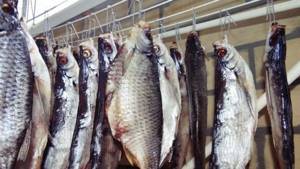
the stage of washing and soaking follows . After washing the fish from any remaining salt and brine, it is left in clear, cool water to soak. This is important and necessary to get rid of excess salt. If you do not soak it, when it dries, the fish will become covered with a layer of salt, dry out and “rust”.
In terms of time, soaking takes as many hours as the number of days the fish was salted. Typically this time ranges from two to five hours. It is best to soak the fish in running water, or change the water every 30 minutes.
It should be borne in mind that during the drying of sabrefish, a lot of fat drains from it; this must be provided for.
You can string saber fish onto hooks by the head or tail. In the latter case, more fat will drain from it.
During drying, the fish should be in the shade and ventilated. If it is hung outdoors in the summer, care should be taken to protect it from flies. In this case, it is best to hang the fish overnight - this way it will have time to weather. Two days after hanging, you can look at small fish and try.
